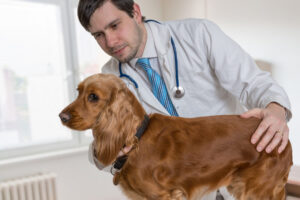
OCD of the shoulder is a risk for large and giant-breed dogs that requires veterinary attention to keep it from becoming a bigger problem later in life.
If your dog is experiencing lameness or pain in their shoulder joint, there’s a possibility it could be osteochondritis dissecans, or OCD, of the shoulder. This condition is painful and can lead to progressive osteoarthritis if left untreated. If you suspect your dog may have this condition it is important to have them seen by a veterinarian as soon as possible.
What is it?
OCD occurs when abnormal cartilage fails to properly form bone in the shoulder joint. This eventually creates a flap that irritates the joint, causing swelling and pain. Eventually, the flap may break off and create what is called a “joint mouse”—a piece of hardened cartilage that is floating within the joint.
What causes it?
It is believed that genetics play the largest role in OCD development, but diet and activity level can exacerbate the condition. It is most common in large and giant-breed dogs who experience rapid growth in their first year of life, becoming apparent between 4 to 8 months of age.
What are the symptoms?
The symptoms of OCD are primarily lameness or limping in one or both forelegs. Other symptoms include difficulty standing up, swelling and redness of the affected shoulder, and crying out when the affected shoulder is touched.
How is it diagnosed and treated?
OCD is most often diagnosed through x-rays, but further diagnostic testing may be needed for confirmation in some cases such as a CT scan or MRI. Your veterinarian will likely recommend testing on both shoulders, even if only one is presenting symptoms.
Treatment options will vary depending on the severity of the condition. Minor cases will be prescribed restricted activity, mobility exercises, and medications that manage swelling and pain. More severe cases will require surgery to remove the flap and manage the affected area. This is typically done through arthroscopy, which is a less invasive procedure that uses small holes and instruments to correct the issue.
Trust Maryland Veterinary Surgical Services With Your Companion’s Health
Your companion’s health is important, and the team at MVSS is ready to provide the best care possible for your furry family. We are dedicated to combining comprehensive exams and assessments with informative and honest discussions of your companion’s care. Once we have worked with you to decide on the best course of action for your dog, our professionals will use their surgical expertise to work towards the goal of giving your companion an active and pain-free life. We are proud to serve loyal companions in Catonsville and Baltimore. To learn more about our services, give us a call at 410-788-4088 or visit us online. For more information and tips for pet health, follow us on Facebook and Pinterest.
